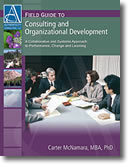Collaborative Consulting for Performance, Change and Learning
Recommended Pre-Reading
All About Internal and External Consulting – Types, Skills and Approaches
Sections in this Topic
- Description
- What is Collaborative Consulting?
- Dynamics of the Collaborative Consulting
- Major Benefits of Collaborative Consulting
- How Much Should Your Clients Be Involved in Collaborative Consulting?
- Responsibilities in Collaborative Consulting
- Nature of the Collaborative Consulting Cycle
- Phases in the Collaborative Consulting Cycle
Description
The Library’s topic All About Internal and External Consulting is a broad overview of the field of consulting. This topic builds on that foundation by explaining one particular style of consulting, collaborative consulting.
Collaborative consulting is not a discovery, development or trademarked service of this author. The general concept has been around in one form or another for several decades, ranging from Carl Rogers’ collaborative approach to psychotherapy to full explanations in Peter Block’s seminal book on consulting, Flawless Consulting.
This topic gives the reader the basic guidelines and resources to begin understanding the process. However, to master the process, the reader should practice applying the guidelines, ideally under the guidance of an already highly experienced consultant.
What is Collaborative Consulting?
Problems With Expert-Based Approaches to Consulting
| See a video about the collaborative approach to consulting, including description, benefits, cycles, shared and individual responsibilities, and collaborating with busy clients. From the Consultants Development Institute. |
A traditional view of consultants is that they are experts who largely work alone in their client’s organizations. They do some very complex analysis, generate highly technical recommendations and then bestow them upon clients — for the clients to implement later on, somehow.
However, research shows that traditional approach rarely works when the consultant is trying to help the client to accomplish significant change in the organization, whether to solve a complex problem or achieve a significant goal. The consultant’s recommendations are rarely implemented, either because they are completely unrealistic, the client is not confident to implement them or they don’t match the culture of the client’s organization. See:
- 10 Myths of Management and Organizational Consulting Part 1
- 10 Myths of Management and Organizational Consulting Part 2
Collaborative Approach Ensures Recommendations Are Implemented
As important as the accuracy of the recommendations is the client’s commitment to actually implementing them. Research shows that kind of commitment comes from their truly understanding the recommendations and believing in them. In turn, that comes from their collaborating with the consultant as much as possible in order to analyze their own situation and what to actually do about it. Overall, that collaborative approach is much more likely to produce the kind of support, momentum and learning that are necessary for successful organizational change.
In additional to organizational consultants, the highly collaborative approach applies to technical consultants, too, especially if the focus of the project is on a complex technical system, where the consultant needs to ensure that the system is adaptable to the client’s organizational culture. Many other helping professions, for example, therapy, social work and education, have also realized the critical role of working in collaboration with others.
Dynamics of the Collaborative Consulting Cycle
Background
Community organizers have long used the philosophy that people who were being served also had to be involved in the effort. For Example, Myles Horton, founder of the Highlander Folk School, used that philosophy to help desegregate schools in the south. Martin Luther King and Rosa Parks both got trained there. Paulo Freire, an adult educator who has been credited with educating more people than anyone else in the world, used the philosophy.
Psychologist, Carl Rogers, suggested a highly collaborative approach in his person-centered psychology. Educator and Organization Development researcher, Edgar Schein, described what could be a collaborative consulting philosophy in his writings about process consultation. Organization Development practitioner and writer, Peter Block, wrote extensively about collaborative consulting in his book, Flawless Consulting. Today, collaborative consulting has become a major movement in various fields of human and Organization Development.
Cycle of Learning in Collaborative Consulting
As explained, very few complex problems are solved merely from the advice of an expert consultant. Instead, they are solved from a cycle of continuous learning between the consultant and client. There are various phases in that cycle of learning.
- If the consultant acts authentically with the client, including being respectfully open, honest and engaging, then the client is much more willing to form a working relationship with the consultant.
- If the client trusts the consultant, then he’s much more likely to seriously consider her expertise and methods in consulting. He is also more likely to seriously consider her coaching in the form of thoughtful questions — questions which can cultivate deep reflection and learning for the client and consultant.
- As a result, the client gains much more understanding and learning about his situation and his organization. He also can more readily explain the situation to other key players in the organization – to those people whose understanding and commitment he will soon need.
- Because of the client’s enhanced understanding and learning, he is more committed to taking actions to solve the problem, and to share the results and learning with the consultant.
- Then, both consultant and client assess whether there was progress in the project, for example, whether a specific milestone was achieved or the overall problem was solved.
Steps 1 through 5 might be repeated until the client agrees that the overall problem is solved.
Major Benefits of Collaborative Consulting
Consultants in organizational change efforts must be able to work comfortably in collaboration with their clients. Often, that starts by explaining collaborative consulting to the client, including why the process is so useful. The following list outlines some of the major benefits of working in a collaborative approach.
- It ensures that consultants work according to the standard goals of professional consultants. According to Block, the primary goals for any effective consultant are to work collaboratively with clients to ensure their current problems are understood, realistic options are identified, the problems are solved — and the clients can solve those problems themselves in the future. A primary working assumption includes that, for projects to be successful, clients must freely provide accurate information and maintain internal commitment to the project. That comes from their collaboration with the client.
- It provides powerful means to identifying the real causes of the client’s problem. Organizations, like people, rarely struggle because of a missing piece of information. Rather, they struggle because they cannot see the situation any differently, they have conflicting feelings about it, or they are afraid to take any actions to address it. Therefore, consultants and clients need to work together to share their own perceptions about the problem. They need to have ongoing discussions about what to do about it and then come to suitable conclusions about what to do to solve it. The client needs to assign realistic accountabilities to take the necessary actions to solve it.
- It ensures that plans remain relevant, realistic and flexible during change. Plans are rarely implemented exactly as planned. Instead, changes inside and outside of the organization frequently cause the plans to be modified. Without the ongoing participation of clients in making realistic changes to the plans, it is not likely that the plans will remain relevant and realistic.
- It ensures the most long-lasting solutions to the client’s problems. Long-lasting solutions to complex problems involve necessary changes to the structures and systems in the client’s organization, not just in inspiring and motivating its people. Changes are not incorporated without the strong, ongoing ownership, commitment and participation of clients. That commitment requires their ongoing trust — the trust that comes from their continual collaboration with the consultant during the project.
- It ensures continuous learning and improvements in consulting projects. Adults learn by applying new information to current and real-world situations, reflecting on the results of those applications and exchanging ongoing feedback with others about their new learning. Projects provide a clinic for learning when the consultant and client collaborate together in the consulting project.
How Much Should Client Be Involved in Collaborative Consulting?
They Should Be Involved in at Least Half of It
Prominent psychologist, Carl Rogers, asserted that you cannot teach anyone anything. People can only learn when they are ready and willing to learn. That is in accordance with Block’s assertion that effective implementation requires the internal commitment of clients.
Block asserts that the consultant should not be contributing more than 50% of the effort in a consulting project. The client should be doing the rest. The consultant should never be doing what the client could do in a project. This is especially true for external consultants. Internal consultants might do more than 50% of the work. However, they still should strive to have clients do most of the work if those clients are to learn to solve their problems for themselves.
Others might believe that the amount of work each party contributes depends on the nature of the services in the consulting project. For example, a technical consultant installing a computer system might do most of the work. However, even in those projects, the client needs to learn the system and how to use it to its full advantage. That will happen if the client is actively involved with the consultant in customizing the right methods of training, practicing how to use the system and in sharing feedback with others about their experiences.
Can Be a Challenge for New Consultants
A challenge, particularly for new consultants, is to actually cultivate a collaborative relationship with clients. They might feel they need to impress and satisfy the client by doing all the work themselves. Or, they might fall victim to the myth that they can somehow descend into an organization and “fix” it without the client ever having to participate. The irony of this situation is that when the consultant follows that approach, the client often reacts positively at first.
However, soon after the consultant leaves, the client realizes that the recommendations were not fully understood — not enough to actually begin implementing them. Also, others in the organization are confused about what to do with the recommendations because little or no learning occurred about them. In effect, the client is in a situation that is worse now than before. So, the consultant’s report sits unread, collecting dust on the client’s shelf. Perhaps worst of all, members of the organization lose faith in the value of ever bringing in a consultant again.
Responsibilities in Collaborative Consulting
Shared Responsibilities
Again, we turn to Peter Block to articulate the shared responsibilities in a collaborative consulting process. These apply for internal or external consultants.
The success of the project is an achievement by both consultant and client. It is not the result of an all-knowing consultant who somehow swooped in and “saved” the organization. Success is really from a continued collaborative approach between the consultant and client to solving the client’s problem.
Decision making comes from the consultant and client engaging in shared discussions, negotiations and agreements. There is a mutual desire to come to consensus, based on the belief that the consultant and client both benefit from each other’s knowledge and wisdom.
The consultant and client share in the discovery, or diagnosis, of the problem, including its causes and the plan to solve it. Only the client can implement the plan, but both can monitor its implementation. If implementation is behind schedule, then both can discuss whether to try get more resources, extend deadlines or reduce expectations in the project.
In a collaborative consultation, both are responsible to identify new learning, that is, new knowledge, skills and abilities gained in the project, as well as new ways of looking at things and making assumptions about them. Learning comes from continued reflection on their mutual dialogue and on the rich experiences in the project.
Consultant’s Responsibilities
- The consultant brings her unique expertise – in particular, in the area of her practice and also in the consulting process itself.
- She uses her skills in coaching to help sustain momentum and learning for individuals and teams in her client’s organization.
- She uses her skills in facilitation to help teams in her client’s organization to become more clear on current priorities and what to do about them.
- She might also use her skills in training to impart certain special knowledge so her client can do a current task or job even better.
- Most consultants have amassed many useful materials and tools to share, so that can be her role, too.
- A primary responsibility throughout the project for her is to help her client to learn.
Client’s Responsibilities
- Regarding the client, he shares information about his organization, including the problems that he wants her to help solve.
- He considers her help in the form of expertise, coaching, facilitation, training and materials.
- He decides what to do with that help, including whether to take actions and if not, to explain why.
- He implements the actions that he agreed to, including to lead implementation of plans in his organization.
- He regularly shares status with her, so both can discuss and decide what should be done.
- Similar to her, he has a responsibility to learn throughout the project – to reflect on his experiences and his working relationship with her.
Nature of the Collaborative Consulting Cycle
The organizational change process is often like that of a wide-ranging and wandering journey between the consultant and client. Accordingly, the phases in the collaborating consulting process are much like a highly engaging and constructive conversation. The various phases provide a common frame of reference during that conversation.
The phases are often cyclical and highly integrated in nature. For example, it is not uncommon to return to an earlier phase because some major aspect of the client’s organization has changed, such as a key leader leaving or a new issue arising in the organization.
There often is no clear-cut distinction between the various phases. The order in which the consultant and client proceed through them and the amount of time that they spend in each depends on a variety of factors, including:
- The consultant’s preferred approach to consulting. See How Consultants Customize Their Approaches.
- The nature of the issues to be addressed by the project, including its focus and the extent of change needed to address the issues.
- Any particular change model that the consultant and client might be using to accomplish organizational change, for example, action research or strategic management.
- The expertise of the consultant while working with the client to proceed through the phases.
- Whether the consultant is working for a service provider who has certain policies and procedures for conducting their consulting projects.
- Whether the consultant is a specialist who focuses primarily on certain functions (Boards, marketing, staffing, etc.) or a generalist focusing on multiple functions.
- Whether the consultant is contracting to provide recommendations only or to guide the client to actually implement the recommendations.
- The amount of resistance from the clients and also from the consultants themselves during significant changes in the project.
- The client’s available resources to commit to the project.
Phases in the Collaborative Consulting Cycle
Various books on consulting usually suggest similar designs, ranging from five to eight phases in the overall consulting process. Authors might use different names and emphasize different terms, but the approaches they suggest are usually somewhat similar. After all, their approaches are often based on the same action research model developed by Kurt Lewin, the founder of social psychology, about 50 years ago.
1. Contracting and Engagement Phase
This phase is also sometimes called the Start-up, Entry or Agreement phase. Although some practitioners distinguish the Start-up phase as being especially about the consultant and client learning about each other and considering whether to connect with each other. They might see the Start-up as being when the consultant and client actually meet together and come to agreement about the project.
This phase is usually the first time that the consultant and client meet. The overall goal of this phase is for both to understand each other’s nature and needs, the intended outcomes from the project and how they prefer to work together. They also begin exploring the presenting priority in the client’s organization, assess the readiness of the client to begin a consulting project, decide if there is a suitable match between them, and then identify next steps, including if and how an agreement can be established.
Guidelines and Resources for Contracting Phase of Consulting
2. Discovery Phase
This phase is sometimes called the Diagnostic Phase. The nature of discovery depends on the philosophy of the consultant and client. Some prefer a rather orderly sequence of phases, while others prefer a more emergent approach.
During this phase, the consultant and client work together in a highly collaborative fashion to further examine the presenting priority, its context and causes, and what can be done to effectively address the priority. Discovery involves carefully collecting information about the priority, how it has been managed and its effect on the rest of the organization. During this phase, the consultant and client might review documentation, administer questionnaires and conduct interviews, to get information about the priority. The consultant will use principles of systems thinking and organizational change to identify issues and generate recommendations to address the issues. Then the consultant and client will share with the rest of the organization the results of the discovery, including issues that the discovery found and the recommendations to address those issues.
Guidelines and Resources for Discovery Phase of Consulting
3. Action Planning, Alignment and Integration
As with the discovery phase of consulting, the nature of the action planning depends on the philosophy of the consultant and client. Some prefer a rather orderly sequence of phases, while others prefer a more emergent approach.
By now, the consultant and client will have a fairly clear impression of what the issues are and the specific actions needed to address them. Now both work together to develop those actions into action plans, identifying who will do what and by when. They will ensure that those action plans are relevant, realistic and flexible and that they are fully integrated with each other. Next, they will integrate the action plans into an overall Implementation Plan that will include plans for evaluation and learning, recognition and communications.
Guidelines and Resources for Action Planning Phase of Consulting
4. Implementation and Change Management
As with the contracting and discovery phases of consulting, the nature of this implementation phase depends on the philosophy of the consultant and client. Again, some prefer a rather orderly sequence of phases, while others prefer a more emergent approach.
During this phase, the consultant will guide and support the client in implementing the Implementation Plan, including its various related plans. The focus of their efforts will be on guiding the implementation according to principles of successful organizational change. The consultant will help the client sustain motivation and momentum throughout the implementation. The consultant will inform the client about a variety of tools to track the status of implementation, as well. During this phase, the consultant and client will continually be evaluating the quality of the change effort and making adjustments as necessary.
Guidelines and Resources for Implementation Phase of Consulting
Also see
Improving Organizations: Guidelines, Methods and Resources for Organizational Change Agents
5. Project Evaluation and Learning
This phase is sometimes referred to as the Evaluation and Adoption Phase, although some practitioners separate the Adoption phase and consider it to be focused especially on ensuring the client has adopted the new practices needed to solve the client’s problem — and also has learned how to solve similar problems into the future.
This phase is marked by having successfully addressed the presenting priority in the client’s organization, as well as having addressed any issues found during the activities of discovery. The consultant and client will conduct an evaluation to verify that those accomplishments indeed were achieved. The client will have learned a great deal during the project, including how to successfully manage change efforts in their organization.
Guidelines and Resources for Project Evaluation Phase of Consulting
6. Project Termination and Closure
This phase is sometimes referred to as the Separation Phase. The consultant and client will reflect on what both have achieved. They will develop a project termination plan that will address how to begin moving out of the project, ethically and administratively. Both will further attend to the results of the evaluation and will clean up any loose ends in the project. They might discuss any future engagements, as well.
Guidelines and Resources for Termination Phase of Consulting
Also See These Closely Related Topics
- Overview of the Field of Organization Development
- Guidelines, Methods and Resources for Organizational Change Agents
- Competencies and Resources for Organizational Change Agents
Additional Library Resources in the Category of Organizational
Change and Development











